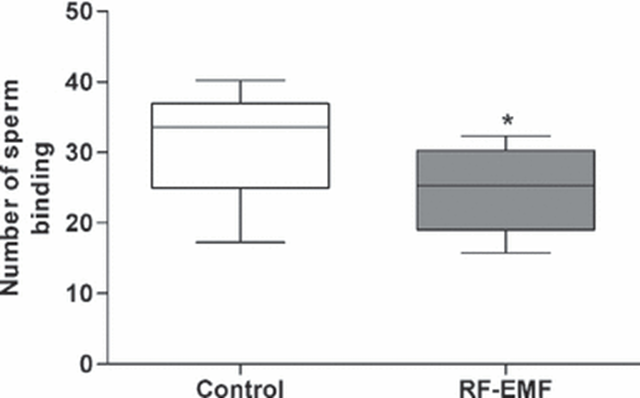Cell phone radiation decreases sperm quality: study
Results of the Wilcoxon-signed ranks test are illustrated in Fig. 2. There was a statistically significant (p = 0.02) reduction in zona binding in RF-EMF-exposed sperms compared with that in controls. Controls bound an average of 31.8 ± 12.8 sperms per hemizona compared with 22.8 ± 12.4 sperms per hemizona of RF-EMF-exposed spermatozoa. Sperm samples from all donors used in this assay bound on average of more than 20 control sperms per hemizona, the minimum criterion for limiting false-negative results with the HZA (Oehninger et al., 1991). Abstract: Several recent studies have indicated that radiofrequency electromagnetic fields (RF-EMF) have an adverse effect on human sperm quality, which could translate into an effect on fertilization potential. This study evaluated the effect of RF-EMF on sperm-specific characteristics to assess the fertilizing competence of sperm. Highly motile human spermatozoa were exposed for 1 h to 900-MHz mobile phone radiation at a specific absorption rate of 2.0 W/kg and examined at various times after exposure. The acrosome reaction was evaluated using flow cytometry. The radiation did not affect sperm propensity for the acrosome reaction. Morphometric parameters were assessed using computer-assisted sperm analysis. Significant reduction in sperm head area (9.2 ± 0.7 μm2 vs. 18.8 ± 1.4 μm2) and acrosome percentage of the head area (21.5 ± 4% vs. 35.5 ± 11.4%) was reported among exposed sperm compared with unexposed controls. Sperm–zona binding was assessed directly after exposure using the hemizona assay. The mean number of zona-bound sperm of the test hemizona and controls was 22.8 ± 12.4 and 31.8 ± 12.8 (p < 0.05), respectively. This study concludes that although RF-EMF exposure did not adversely affect the acrosome reaction, it had a significant effect on sperm morphometry. In addition, a significant decrease in sperm binding to the hemizona was observed. These results could indicate a significant effect of RF-EMF on sperm fertilization potential. … The reported decline in male fertility (Andersen et al., 2000; Joffe, 2000; Swan et al., 2000; Skakkebaek et al., 2001) can be ascribed to several environmental factors (Sheiner et al., 2003; Claman, 2004) among which radiofrequency electromagnetic field (RF-EMF) emitted by mobile phones is one of the reported possible causes (Erogul et al., 2006; Agarwal et al., 2008a). Several studies that show an effect of mobile phone irradiation on human spermatozoa are available. Aitken et al. (2005) reported on a genotoxic effect of RF-EMF, whereas other studies indicated an effect on sperm motility (Erogul et al., 2006; Wdowiak et al., 2007; Agarwal et al., 2008a,b) as well as morphology (Agarwal, 2007). However, in contradiction with previous reports, our recent study revealed that pulsed 900-MHz mobile phone radiation operated at a specific absorption rate (SAR) of 2.0 W/kg, the maximal permissible transmission power under current standards (ICNIRP, 1998), did not adversely affect specific sperm motion parameters as determined by computer-assisted sperm analysis (CASA; Falzone et al., 2008). Nonetheless, a decline in motility alone does not render spermatozoa incapable of fertilization. … The study revealed a significant reduction in morphometric parameters in exposed sperm; however, surprisingly, the acrosome reaction was not affected. In addition, sperm–zona binding decreased significantly in exposed samples. These findings were indeed unexpected considering that we previously noted no effect on sperm motility (Falzone et al., 2008). Given the significance of these results, RF-EMF could potentially affect male fertilization potential. …
N. Falzone, et al., “The effect of pulsed 900-MHz GSM mobile phone radiation on the acrosome reaction, head morphometry and zona binding of human spermatozoa,” 7 MAR 2010, DOI: 10.1111/j.1365-2605.2010.01054.x
